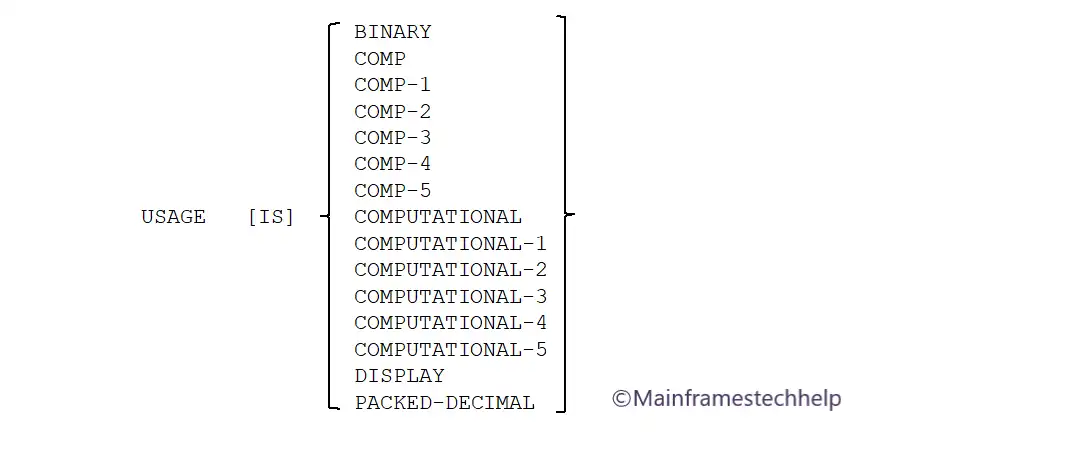COBOL Computational Items | USAGE Clause
Computational items refer to data items used for arithmetic calculations. These items are typically defined with the USAGE clause to specify their internal representation.
The USAGE clause explains how data is stored in memory and how the calculations are performed on that data. Different USAGE modes, such as BINARY, PACKED-DECIMAL, and DISPLAY, specify the internal representation of the data. The USAGE mode can impact storage requirements and the efficiency of arithmetic operations.
Points to Note -
- The USAGE clause is used to reduce the storage space and increase the efficiency of the program.
- Every variable declared in COBOL has a USAGE clause directly or indirectly.
- It can be coded with any level number other than 66 or 88.
Syntax -

DISPLAY
DISPLAY computation uses the character form. In character form, one character equals one byte (8 bits) of storage. If no usage clause is used, then DISPLAY usage will be applied by default.
It applies to the Numeric, Alphabetic and Alphanumeric data types. For example -
01 WS-VAR.
05 WS-VAR1 PIC 9(06) USAGE DISPLAY.
05 WS-VAR2 PIC 9(06).BINARY | COMP | COMPUTATION
COMP (BINARY) stores signed decimal numbers in pure binary format and applicable to numeric data items. This format is often used for arithmetic operations as it provides efficient storage and fast computation. The below table represents the storage occupied based on the number of digits in the PICTURE clause –
| Digits in PICTURE clause | Storage occupied |
|---|---|
| 1 through 4 | 2 bytes (halfword) |
| 5 through 9 | 4 bytes (full word) |
| 10 through 18 | 8 bytes (doubleword) |
For example -
01 WS-VAR.
05 WS-VAR1 PIC 9(5) USAGE IS COMP.
05 WS-VAR2 PIC 9(8) COMP.Both WS-VAR1 and WS-VAR2 occupies 4 bytes of memory.
COMP-1 | COMPUTATION-1
COMP-1 stores the numbers as single-precision (32 bit) floating-point numbers and applicable to numeric data items. It has no PICTURE clause, which is 4 bytes long (FULL WORD). COMP-1 data is stored in the format of mantissa and exponent.
| Digits in PICTURE clause | Storage occupied |
|---|---|
| 1 through 16 | 4 bytes (FULL WORD) |
For example -
01 WS-VAR.
05 WS-PI USAGE IS COMP-1.
05 WS-RADIUS USAGE IS COMP-1.COMP-2 | COMPUTATION-2
COMP-2 stores the numbers as internal double-precision (64 bit) floating-point numbers and applicable to numeric data items. It has no PICTURE clause, and it is 8 bytes long (DOUBLE WORD). COMP-2 data is stored in the format of mantissa and exponent.
| Digits in PICTURE clause | Storage occupied |
|---|---|
| 1 through 32 | 8 bytes (DOUBLE WORD) |
For example -
01 WS-VAR.
05 WS-PI USAGE IS COMP-2.
05 WS-RADIUS USAGE IS COMP-2.WS-PI and WS-RADIUS both occupies 8 bytes memory even though the data sent is smaller.
COMP-3 | COMPUTATION-3
COMP-3 (or Packed Decimal or Packed Numeric) stores the decimal numbers in a compact binary-coded decimal (BCD) format and applicable to numeric data items. COMP-3 variable contains any of the digits 0 through 9, a sign. It can have a value not exceeding 18 decimal digits.
The formula for memory calculation of the COMP-3 with n digits (variable length + 1 byte for SIGN if exists) in the declaration is -
- No. of bytes = Round ((n + 1)/2) - Where n is an odd number.
- No. of bytes = Round (n/2) - Where n is an even number.
For example -
01 WS-VAR.
05 WS-WIDTH PIC S9(02) USAGE IS COMP-3.
05 WS-AREA PIC S9(06) COMP-3.WS-AREA variable is declared as COMP-3, with a signed byte plus 6 digits. A total of 7 bytes and the (n+1)/2 formula will apply as n is an odd number. So, a total of 8/2 = 4 bytes allocated for WS-AREA.
COMP-4 | COMPUTATION-4 | COMP-5 | COMPUTATION-5 -
COMPUTATION-4 or COMP-4 or COMPUTATION-5 or COMP-5 is the equivalent of COMP or BINARY. The data items are represented in storage as binary data.

